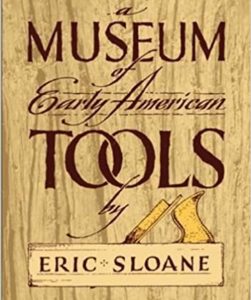By: Eric Sloane published 1964

Price : $
Philip’s Ranking: 4
Beginner Blacksmith: 3
Advanced Blacksmith: 1
Inspiration: 3
Historical: 4
Video Review: N/A
User Reviews of A Museum of Early American Tools
Table of Contents

- The Romance of Tools – pg 2
- Crude Shops, Magnificent Results – pg 8
- An Ax is and Axe! – pg 10
- A World of Axes – pg 12
- The Broad Axe – pg 14
- How the Broad Axe Was Used – pg 16
- A Giant and a Midget – pg 18
- The Hatchet – pg 20
- Hammers – pg 22
- The Axe and the Log House – pg 24
- The Adze – pg 26
- Canoes and Bowls – pg 28
- Wedges and Froes – pg 30
- The Fine Art of Splitting – pg 32
- Tools with Legs – pg 34
- The American Horse – pg 36
- For Making “Snitzels” – pg 38
- Little Shavers and Big – pg 40
- The Days of River Rafting – pg 42
- Tools of the River Lumberman – pg 44
- Of Cider and Apple Butter – pg 46
- To Remove Bark – pg 48
- Two Heads are Better Than One – pg 50
- The Chisel – pg 52
- Chisels and Gouges – pg 54
- Planes pg 56 – 64
- The Moudling Plane – pg 58
- The Rabbet – pg 60
- The Plow – pg 62
- Early American Saws – pg 66
- A Gallery of Frame Saws – pg 68
- The Biggest Saws – pg 70
- To Make a Hole – pg 72
- To Make a Bigger Hole – pg 74
- To Brace or Bitstock – pg 78
- The Things You’ll Find in a Barn! – pg 82
- Some Were Special – pg 84
- These Were Tools Too! – pg 86
- Jacks – pg 88
- The Blacksmith – pg 90
- Wrought Nailmaking – pg 92
- Tanners and Curriers – pg 94
- About Wheels – pg 96
- It’s All in the Way You Hit It – pg 98
- Hay Implements – pg 100
- Knives and Grass – pg 102
- Found in the Barn – pg 104
Review
This is not specifically a blacksmithing book so why do I have it on my list and why do I rank it so highly for beginning blacksmiths?
Blacksmithing is a very old craft and historically the blacksmith supplied any metal tools that any other craftsman used. As modern production methods, industrialization, technology reshaped our world a lot of what historical blacksmiths did was forgotten. A book like A Museum of Early American Tools is a glimpse into how the blacksmith supported and was shaped by the community they lived in.
For the modern blacksmith this knowledge helps them most immediately when they start getting the inevitable questions around old tools or metal objects from friends and family. If people know you blacksmith suddenly their phones will be out with photos of all kinds of random antiques asking you what it is. It’s nice to be able to answer those questions.
When you do see that photo, find something in an old barn or antique store, or flea market a basic historical background will help you figure out if you have an opportunity to pick up a piece of historical smithing equipment. If you have a good knowledge of old tools and techniques you might be able to find some real treasures sitting on a shelf that no one else understands.
There is also a small modern demand to recreate old tools. Just as blacksmithing has taken off in popularity things like hand tools for woodworking, bush craft, and other classic skills have also exploded in popularity and those individuals are frequently interested in reproductions of old tools that can’t be purchased unless they are custom made.

The section on “Things You’ll Find in a Barn!” is a very typical example of exactly what you see in this book. There will be a brief paragraph two of text on a historical craft, type of tool, or task and then a page and half or so of drawings of the tools relevant to the subject.
There are never dimensions given and rarely multiple views of the same object which is limiting. Sloane does provide one or multiple names, a couple words about how the tool might be used, and dates (which are unsourced). This is still extremely useful because knowing something exists and the the right name unlocks the ability to tap into all the modern search capabilities.
Will this book teach you anything about swinging a hammer? No.
Will it provide any detailed plans or projects? No.
Will it provide knowledge, inspiration, and introduce you to the products of the historical blacksmith? Yes
For me that third reason is enough to keep this on my shelf so that I can flip through it as a reference or for ideas.
User reviews of A Museum of Early American Tools
There are no reviews yet. Be the first one to write one.